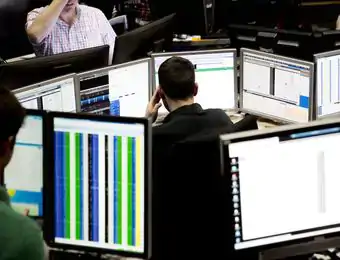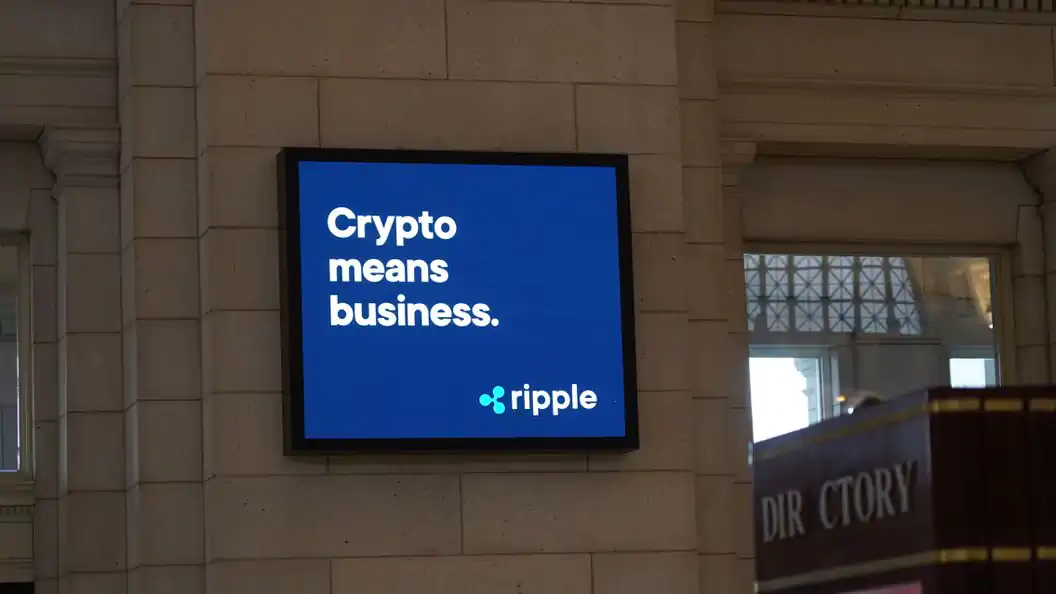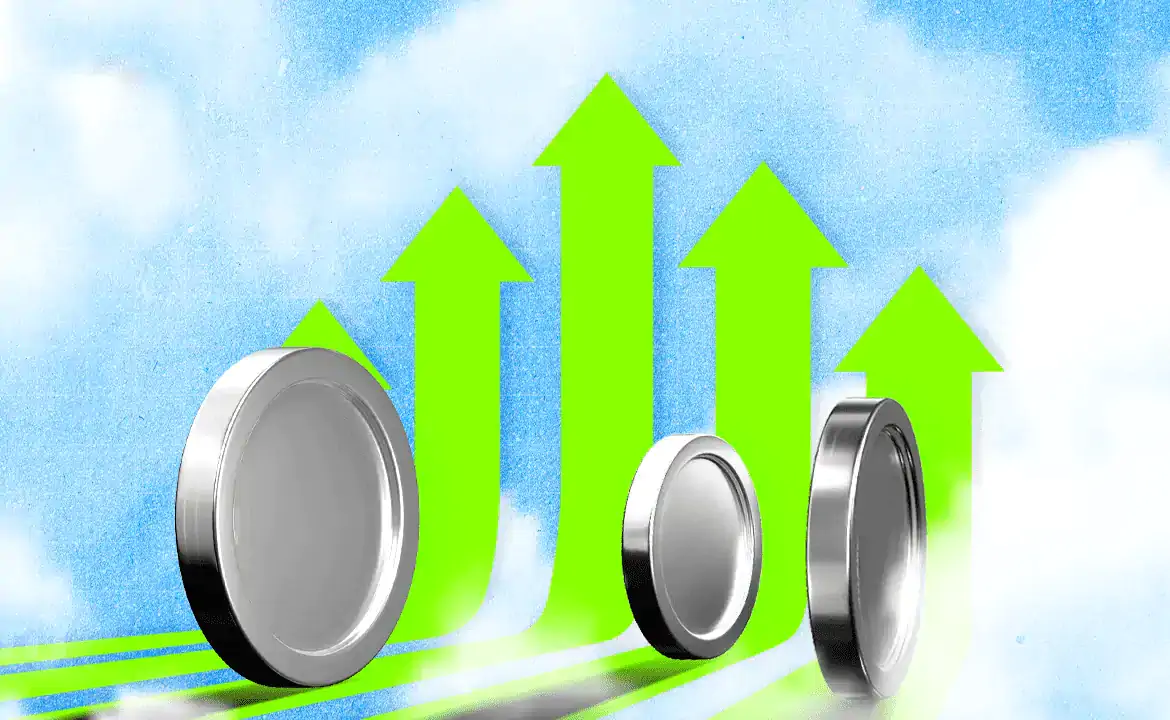A stabilizing or destablizing force?
A trader looks over computer monitors as he works in the Cboe Volatility Index (VIX) pit on the floor of the Cboe Global Markets, Inc. exchange in Chicago, Illinois, U.S., on Wednesday, Feb. 14, 2018.
Photographer: Daniel Acker/BloombergJoe Weisenthal
Tracy Alloway
Recent months have seen an explosion in so-called 0DTE options. These equity derivatives are highly volatile and short-term in nature. And they’re proving to be popular with retail traders and professional portfolio managers. But are they a source of potential systemic risk? Could they create a volatility doom loop? On this episode, we speak with Nomura cross-asset strategist Charlie McElligott about the phenomenon. The transcript has been lightly edited for clarity.
Key insights from the pod:
What are 0DTE options? — 5:57
Why do we need such short-term options trading? — 8:18
Why selling vol was so profitable post-crisis — 10:00
The mean reversion of short-term options — 16:50
How the short-vol trade blew up — 22:15
Why volatility has remained muted despite the selloff — 26:15
Are these options creating greater intraday swings? — 36:22
What would make these derivatives dangerous? — 40:04
Tracy Alloway: (00:10)
Hello and welcome to another episode of the Odd Lots podcast. I'm Tracy Alloway.
Joe Weisenthal: (00:14)
I'm Joe Weisenthal.
Tracy: (00:16)
Joe, do you remember Armageddon?
Joe: (00:21)
Keep that in. Keep that in.
Tracy: (00:27)
Ok Joe, you remember VOLmageddon?
Joe: (00:30)
Yeah. If you asked me exactly when that was, I don't know if I could say.
Tracy: (00:34)
Joe: (00:35)
Okay. I wouldn't have necessarily said that. Maybe 2017 or something, but yeah, something crazy happened and like something with like the VIX and some ETN or something, I dunno.
Tracy: (00:45)
This is a moment in market history that lives for free in my head. Yeah. Because a lot of interesting things happened. So for those who might not remember all the details, there were these two little volatility products, two exchange traded notes that basically ended up having this huge impact on the market and specifically the volatility index, the VIX. And so you had this kind of tail wagging the dog scenario where you had two products that ended up impacting the overall market.
Joe: (01:20)
Yeah. And you know what was really notable about the post-2010s environment is that just keeping a steady short volatility trade on was extremely profitable for years. And people sort of just got lulled into that, because you know, "buy the dip" was like this sort of dominant thing. You had the Fed sort of on your side typically playing, uh, some role of, you know, the Fed put and all of that, and you had the residual anxiety of the crisis. So people were paying a large premium for protection, right. Relative protection. So being a seller of that and sort of being implicitly short volatility was just great until the one day it wasn't.
Tracy: (01:57)
This is why these two exchange traded notes came into being in the first place. It was because people wanted to be able to sell volatility. And I remember they became very popular with a certain faction of retail traders. There was even a subreddit called TradeXIV, which was the name of one of the notes. It has since rebranded to Trading Vol because we had this Volmageddon situation and both of these exchange traded notes ended up collapsing. So not only did they sort of spark this wider move in the market, but they ended up dying because of it.
Joe: (02:32)
Interesting in retrospect, and I hadn't really thought about this, but what's interesting in retrospect about this story is that, okay, in 2018 the retail move was like, okay, trade XIV or go long XIV. And that was sort of how people played this post-2020. Now you get the sense that retail is playing derivatives more directly, particularly call options. So then, exactly. Rather than some note or instrument that implicitly did that. Now of course the story of Robinhood and all that is lots of people are just getting directly into options trading directly.
Tracy: (03:06)
That's right. And the big story in options right now, and the reason I brought up Volmageddon not Armageddon, which thankfully hasn't happened yet.
Joe: (03:16)
Recording this March 8th. So we'll say...
Tracy: (03:18)
Thank you for the caveat. You never know. Alright. So the reason why we're talking about Volmageddon is because you have this new type of option on the scene. They're called one day or zero day options, 0DTE or 1DTE. And they've kind of exploded in volumes in recent years and there's a lot of discussion about whether or not they are going to lead to a similar aged type scenario where you have, you know, this small thing, although they're not that small anymore, but you have this small instrument that ends up having a cascade effect on the market and leading to a bigger effect on the S&P 500, the benchmark index.
Joe: (03:59)
And there's always these concerns that any sort of derivative instrument, which is, you know, might be used for hedging purposes, could have this feedback loop. And of course, the classic example there is like 1987 and Black Monday. Yeah. And the, uh, the stock market insurance or whatever they called it, portfolio-
Tracy: (04:16)
Insurance.
Joe: (04:17)
Yeah. And the other thing you note, and this is sort of what's interesting to me and why we're talking about this, it's like in 2021. I think we had a very good story for why there was so much of this sort of 0DTE expiry option trading. Right? The story's like, oh, these new degenerate gamblers and they're on Robinhood and they're like trading these hyper-volatile derivatives that, you know, they're short-term bets and they're just being swung.
We've had this cooling off of speculative activity over the last year as clearly seen by prices. You know, Bitcoin and ARKK and all these things have come way down from their high, and yet the level of trading in these instruments is still very high. Which complicates the story that, “Oh, it's just a bunch of like retail at home gamblers.”
Tracy: (05:03)
Right. I was about to say, I think it hints that maybe it's not just retail. Yeah. And this is something that I've written about on Odd Lots and you should all check it out. And speaking of what I wrote on Odd Lots on the blog recently, we are going to actually be speaking to the perfect guest. We're gonna be speaking with Nomura cross-asset strategist, Charlie McElligott. He was the author of a very, very good research piece that I wrote up a couple of months ago and has been writing quite a lot about this topic. So Charlie, thank you so much for coming on Odd Lots.
Charlie McElligott: (05:32)
Excited to be here. Long time listener, first-time caller.
Tracy: (05:37)
Maybe just to begin with, talk to us about what these options are exactly and how they came into being and also their intended purpose. Because I think nowadays people talk about them as, oh, it's part of the speculative betting frenzy, but I assume they're supposed to serve some sort of purpose.
Charlie: (05:57)
Absolutely. So, you know, I would almost start this conversation going backwards by saying, look at the stock chart of the CBOE right now. Which is almost a proxy on the explosive growth and usage of options, you know, from the investing community, whether it's institutions or retail investors. And it does fit somewhat tightly with this larger kind of speculative excess boom of the past two and a half, three years.
And that post-crisis period and the Wall Street Bets stuff that you guys just spoke about, you know, the stimulus checks and, you know, SPACs to, crypto, you know, this kind of new world of leveraged highly convex payouts. Mm-hmm. is a place where flows and money followed. And this is the type of return profile that people are really looking to exploit in this day and age.
And in that sense, that's the unspoken portion of why these have been rolled out and offered. Now there are daily expirations, there's an expiration for every day of the week, and the zero DTE product is now almost 1-out-of-2 options that trade with the SPY ETF, for instance. So effectively there too for large S&P, which is almost exclusively an institutional product.
So the demand is there. I think the official line probably from the exchanges would be something to the effect of we want to offer the end users more tools to manage their risk, manage their liquidity profile, things of that nature. And look, that is not wrong either.
Tracy: (07:39)
When did CBOE actually launch these?
Charlie: (07:42)
Kind of call it mid last year?
Joe: (07:45)
Oh, okay. So they really have not been around very long. So options, right. Hedge risk, that's what they're all about in theory. And someone like maybe takes a more speculative position, someone needs the hedging, they trade an option, et cetera. How do you go about trying to decompose how the instrument is actually used and how much is it from, okay, you have a large portfolio manager that needs to hedge their downside, et cetera, versus how much of it is being driven by someone who wants to make a bet on what Tesla will do tomorrow?
Charlie: (08:18)
That's a great point. And I think that is where, you know, at this point you know, myself, my colleagues, Anthony Antonucci and Joanna Wang have done some pretty quality work here. I think unpacking that exact idea, like just looking at open interest, just looking at volumes themselves is not indicative of anything. Right. We need to get a sense for, you know, are the net end users buying or selling these? Right.
It speaks to the macro regime. It speaks to the volatility regime. Right. You could say it to a certain extent, looking back in the kind of QE era, let's say where we did where Fed was in active suppression of volatility mode, large scale asset purchases, 0% or negative interest rates, you know, that was part of this idea. You create a wealth effect. Financial conditions are easy, it's a growth tailwind, all that good stuff. Virtuous stuff happens. The Fed was telling you to be leveraged long assets. Right. So you had a need for hedges to a certain extent. Take a measure like skew, right. Which is a measure of kind of downside demand relative to upside demand.
Tracy: (09:26)
The Credit Suisse fear barometer, right.
Charlie: (09:28)
Right. Yeah, to a certain extent. So, or even, you know, specifically put skew, which is like demand for a tail or crash put relative to something closer to the money. Those measures were very high; skew was very steep back then because you're long, leveraged, long assets, and you needed downside protection.
Joe: (09:47)
This gets to the point though, of why selling volatility like XIV was so profitable. Because if you have so much demand, you have the structural demand for protection, and lots of buyers create a good market to be a seller.
Charlie: (10:00)
Exactly. And what it does, I mean, the way that you look at volatility is kind of different from this. What I've learned from being in the volatility space, specifically within the Nomura equity derivatives desk for the last five years, which is a top three market share player in the US options space, is that it's a consistent shuffling of your feet. You're trying to find value, you're trying to find highly convex payouts.
To a certain extent, that's why these options exist in the first place. Why there's so much demand for them. You have a defined risk but a much larger, multiple times implicit leverage on the payout if it strikes gold, to a certain extent. So you're kind of range trading when volatility is cheap when you want to be adding protection, and when volatility is rich, that's typically when you want to flip positions and be short volatility or short gamma.
Those are all part of the calculus here. I think what matters then, however, in this QT era, where the Fed has their hands tied in light of the inflation overshoot and this dynamic where they were clearly behind the curve. Just a year ago, they only stopped buying bonds before they even began their first hike; they were still buying bonds. So they've needed to tighten financial conditions, they've needed to try everything they can in their limited toolkit to address the wealth effect that was caused by these legacy 10-year-plus easy financial conditions. That means cramping the demand side of inflation through tightening FCI. And in this case, what QT has meant was a very simple trade.
That's why there was such a clear trend in 2022, like long dollar and short assets. That's why, for instance, CTAs were up around 30%. There was a very clear defined trend. The Fed was effectively telling you to be short assets. What we saw then was this trade that still exists to this day, even with the most recent Jerome Powell commentary, which involved a view that when you're in a stretched equities valuation, the Fed is de facto a seller of calls. At the low end of the equities valuation, they don't want a market crash per se either.
Then they kind of talk you off the ledge and they're a seller of puts. So we're bouncing around this range, but in a QT era where they're shrinking the balance sheet or raising rates, they're trying to tighten financial conditions. It kind of perversely creates a situation where you're being told to be short assets, and you actually don't need as much hedge protection. That's part of the reason why VIX has been so low. If you don't have a lot of exposure and you're sitting in high cash or low nets, you don't need a lot of crash downside protection.
Joe: (12:56)
This is such a clear answer that finally makes so much sense. If the Fed is telling you to hold more cash and not be so leveraged, then you sort of have your built-in hedge already.
Charlie: (13:10)
Cash is an at-the-money put.
Tracy: (13:30)
So just a basic question, I know you've done some research on this, but what does the split actually look like between institutional versus retail usage right now?
Charlie: (13:38)
Well, I think that's part of the fuzzy assumption that makes this an uncomfortable discussion. I don't truly trust many of the figures, whether it's cash percentage of the overall cash equities universe or assumptions about options trading with regards to what is retail versus institutional. I think a lot of people do a naive analysis looking at the size of options contracts and then, under a certain threshold, they'll label those as retail size, which can create a potentially false narrative. The issue is that, particularly with this product, it's an electronic options product, which means a market maker is the counterpart.
But who are the savviest electronic options market makers with the best algorithms and risk tools? It's these entities that are incredibly skilled with their algorithms, slicing and dicing up their risk all day. So you won't see huge blocky types of flows that you could typically pinpoint as retail.
Joe: (14:59)
Just because something is an odd lot doesn't necessarily mean it's retail.
Charlie: (15:02)
Correct. In my past career on a cash desk, I sat at a dot machine and had a time schedule for every minute of the day for various orders. That's how it worked, and now imagine that with a much larger risk order. So I have a hard time attributing retail vs. institutional here. However, one thing I will say is that recently, we've seen some large put buying, which proves that this is largely an institutional product.
Tracy: (16:01)
This leads to my next question, which is about the unusual aspect of these shorter-dated options where the split between put volume and call volume is very skewed in one direction. Why is that?
Charlie: (16:17)
Well, I think the simplest thing I would say right now is that this product is constantly evolving, and each day is its own ecosystem with these products. So there's not necessarily going to be a carryover of the prior day's trend, but generally,
Tracy: (16:43)
So you could have a day where it's mostly puts, which it has been so far, and then you could have a day where it's mostly calls.
Charlie: (16:50)
To a certain extent, but this is the core of how these things are trading right now, by and large, there's an inherent, almost by definition, mean reversion flow from these products because whatever you're putting on intraday, if it's moving in your direction, ultimately needs to be unwound and monetized. So the actual impact that you're getting, let me walk you through the way that we're identifying these flows and trying to assign a buy or sell. The CBOE handles options flows for index and ETF options, and what we do is they assign an end-user tag. There are broker-dealer tags, traditional upstairs big bank options dealers, for example.
Joe: (17:43)
Could you clarify what you mean by "upstairs"?
Charlie: (17:49)
Sure. In this context, I'm referring to high-touch sales traders and risk takers, not necessarily on the floor of the exchanges but more associated with large balance sheet banks.
Tracy: (18:04)
Big stuff. Okay. If we did a subscriber-only version of Odd Lots, we could call it "Upstairs."
Charlie: (18:11)
I like that idea, to be quite honest. So, in this case, the broker-dealer tag with these products doesn't have a clear angle to these flows. Some days they are long, and some days they're short. Market makers, in this definition, are those electronic options entities that we're speaking about, the very tech-savvy newer players in the scene. By and large, they are the net sellers, the source of supply for the end-users. The net end-user is actually a customer tag, which includes people trading at home, institutional clients, retail, etc.
We look at buys of calls, sales of calls, buys of puts, and sales of puts. We see a clear pattern: market makers are almost always net sellers, and customer flows are almost always net buyers. This is core to the discussion right now because, as it relates to this larger topic of volatility, that's the setup I'm most comfortable with. The seeming day trader is more into creating gamma and momentum flow in the market. They have a defined risk, spending the premium on the option, and most of these options will expire worthless as they move out of the money.
Tracy: (20:52)
So, before we get into knocking down the "volmageddon" argument, can you explain it to us? There was a JP Morgan note recently suggesting that a 5% drop in the S&P 500 could snowball into another 20% drop due to these options. Talk to us about the dynamics that would drive that cascade effect in theory.
Charlie: (21:30)
In 2018, during the VIX event, there was a steep skew. Volatility appeared attractive to sell due to Fed macro suppression, and there was no yield in fixed income. This led to the growth of volatility selling strategies and yield enhancement strategies. It wasn't just about hedge funds but also the largest asset managers.
Tracy: (22:11)
Bill Gross stood up on stage and said sell volatility.
Charlie: (22:15)
That's how he did it. He was the biggest volatility seller out there. So, this discussion is more than just about equities. There was a buildup and accumulation of short volatility in the market, and the larger the short volatility trade got, the more risky it became. It's like picking up pennies in front of a steamroller – you're just collecting premium and income.
Then, in December and January, the Trump tax plan went from a low probability to being approved in the House or Senate by mid-December. We were already experiencing above-trend growth and inflation, and this fiscal boom led to an unstable market with equities up and volatility up. Over the course of that month, we kept seeing prices paid beats and CPI releases. On the Friday before the VIX event, there was an average hourly earnings print that was a significant beat, leading to the first real inflation scare.
There was a "holy smokes" moment, and there was an inflation scare. All of a sudden, the seemingly very controlled forward path and the visibility of the Fed keeping rates low forever was no longer a thing. That morning, the S&P traded down two and a half percent, I think, that Friday. These products started to come unglued, and a lot of people were short these things, having to turn by the end of the day.
Tracy: (24:19)
The craziest thing is they were tied to VIX futures, and I think the week before, you could see the VIX curve start to invert, and everyone knew what inversion would mean for these products. I remember tweeting about how VIX curve inversion would be really bad for these two ETMs. And then it happened, and everyone was shocked. A significant proportion of retail seemed to be shocked, which was unfortunate, but you could see it coming.
Charlie: (24:51)
Right, I called it a neon swan at that time. We knew that you needed a catalyst, and it was probably, as always, as we've seen with this most recent multi-year period, the volatility catalyst was inflation because it shocks you out of this lazy QE mentality, zero-bound rate mentality.
Joe: (25:31)
Moving back to the present day, there's good reason to believe this is heavy institutional or active buyers of these zero days to expiry options. The demand is real for it. What is it about the characteristics of current large-scale institutional portfolios that standard longer-dated options are not as good for? Why do they need such short-term protection?
Charlie: (26:18)
Well, I think what you want to do is look at the shifting volatility regime in a QE versus QT era. Last year, skew flattened to the zero percentile. That tells you there was a general under-positioning that didn't require hedges. It was a crash-less selloff, a grinding de-leveraging.
Joe: (26:46)
But why do they need the zero-day options to get the level of protection?
Charlie: (26:55)
That's the perversion here. So many tail funds didn't perform well last year because typically tail funds are owning the crash stuff. You need to finance paying for the hedges that you put on by being able to be short in volatility. But because we never crashed, owning gamma into these event risks didn't pay out. So, and owning puts didn't really pay out because it was this grinding spot down vol down environment.
Skew was flat. The actual only days we really saw vol perform were on crash ups because nobody had it on. Nobody was worried about a further selloff because you had such low exposure or high cash, as we already said. Much of the event risk last year was a CPI print, an NFP, an FOMC meeting, or an ECB meeting. So you wanted something that really looked alike and was going to be highly sensitive to that day's move. If you were a hedger, people were buying at the money same day puts. A one month put or a quarterly put was not doing you any good. Owning put spreads for some gamma was not doing you any good.
The migration of the flow moved to these daily options. Each day became its own ecosystem. If you are hedging those risks, if you are a market maker selling into this end user who has demand to push the market around either way, whether it's buying puts or buying calls, owning a Friday option, a weekly option, or a monthly option is not going to have the same impact in hedging your risk. Part of the volume proliferation that we have seen this year is the market makers and broker dealers themselves using these products to slice and dice their own risk profile. It's symbiotic with the underlying demand.
Tracy: (29:28)
In this environment, maybe you're worried about a big intraday move because of event risk, so you're going to buy a short-dated option or a zero or one-day option versus a weekly or a monthly. What does that actually mean for the impact on the market? The whole aged portfolio insurance doom loop theory is that you end up in a situation where the whole market is basically short gamma and keeps declining, and then market makers have to keep selling to hedge. But with these ultra-short options, maybe it could make the market more volatile on a one-day basis, but probably not going to lead to a 1987 type situation.
Charlie: (30:23)
In one of my recent notes, there was a span at some point in February, over 10 days, seven days, I think we had 15 or 16 1% moves in both directions in like a week and a half.
Joe: (30:41)
And when was this?
Charlie: (30:42)
I want to say it was the first week and a half of February.
Joe: (30:45)
Charlie: (30:46)
When the velocity of mentions of this became a trending conversation. At that point, we were printing the high usage points of these options to date; one out of every two options was a zero DTE option. What you were seeing then was the enhanced intraday volatility because when these options were net bought by the customers, the dealers have to go and hedge that gamma. This came part and parcel with the democratization of financial information and the democratization of trading, making it like a video game. This was that highly convective, low-risk, lottery ticket phenomenon. And this has become a powerful flow, and people now get the joke from retail to former institutional folks that didn't think about options as a vehicle.
Tracy: (31:57)
Joe, you might remember I wrote about this in the newsletter, but this to me is like the legacy of crypto. People bet on ever shorter-term events and they're kind of agnostic to price. It's like, does the market go this way or does it go that way?
Joe: (32:16)
How big is that activity today in early 2023 in your view, relative to where it was in the middle of 2021? Obviously, a lot of those people must be gone or wiped out, but there's still a lot of people doing it and talking about it. So, how much of a force is that today versus back then?
Charlie: (32:48)
In the absence of a clear macro message, and with the market held hostage by individual macro data points or central bank meetings, there has almost been a trader boredom. People need to exploit some other phenomenon where they're dealing with binary outcomes. If you are a market maker or a dealer and you have clients looking to exploit these intraday moves, there's also a regulatory paper trail aside here. Because if I'm selling an option and at the end of the day, it's not on my prime broker's books because that trade is gone, I don't have to deal with the margin requirement.
The collateral requirement also plays a role. As opposed to using a futures order, which you would put a stop loss for risk management, in this type of world, you put your stop loss at a certain level, and the market might reach that point and execute, forcing you out of your position even though you wanted to be long. By the end of the day, the market is higher and you've lost out. These options give you a chance to not get knocked out.
Tracy: (34:50)
I didn't realize that about the margin requirements. That's interesting.
Charlie: (34:53)
These factors are all part of the tailwind to these products. Market makers are basically positioned short of put and short of call on a daily basis. Our data shows that almost every day, particularly when we look at certain buckets, there is almost always a net customer buyer trying to create that gamma squeeze. But so are puts in the 97-99 range, almost always a customer buyer. You're trying to push these flows around.
Tracy: (35:39)
Is there a chance that you could see something or you're already seeing something similar here where sophisticated market participants understand how these options work, the hedging activity they generate, and they start to sort of game them?
Charlie: (36:22)
Yes, but it's more like intraday gaming. The inherent mean reversion property of these options requires monetization by the close. This feeds into the intraday volatility expansion, lifting a guy on upside calls and the market starts rallying. As the market goes higher, they have to buy more to stay hedged.
These are accelerant flows, the same thing to the downside. It's within the bounds of fair play. We've seen futures on our options on futures trading lately where people are clearly doing this on the screens. A week or two ago, the market moved because there was $2 billion of Delta for sale, and everybody saw that and knew it.
Executing these trades can significantly impact the market and leave a footprint. We've seen futures on our options on futures trading lately where people are doing this clearly on the screens. They're buying 20,000 options on futures down 50 points in the middle of the day, and puts. A week or two ago, the market moved because there was $2 billion of Delta for sale. Everyone saw that and knew it.
Joe: (37:40)
Can you talk a bit about payoff probabilities and walk us through a theoretical trade, including the math behind how someone would enter and think about the upside and downside?
Charlie: (38:17)
Without getting into a complex option strategy, if you were simply buying same day call options, through the end of January, running a systematic strategy of buying and closing, you would be up around 5% consistently, with a positive Sharpe ratio. This is unusual because January was an everything-rally. Market makers want to be short these options, which is a critical part of the process, especially in this volatility regime.
Joe: (39:15)
You mentioned the first day of the Powell testimony on the Senate.
Charlie: (39:18)
In terms of the Sharpe ratio, which measures performance versus risk, shorting a daily straddle or strangle is what these market makers are doing. Over the last 10 days, the S&P has had a Sharpe ratio of 7. Selling that straddle systematically over 20 days pushes it up to around 5 in the S&P. This is a significant payout for these market makers.
Joe: (40:02)
So, what is the regime shift scenario in which market makers could get run over? They're short puts and calls, essentially making bets on not having big moves, right?
Charlie: (40:18)
To a certain extent, we haven't had any crashes, just declines. Part of that is perhaps due to deleveraging and people having more cash on the sidelines, so they don't have to sell in response to selling. But what is the scenario in which a market maker with these short straddles could get run over?
Charlie: (40:45)
In the dynamic we're discussing, which has been the setup for most days, it's actually a good thing to have short volatility and short gamma managed by professionals with regulatory oversight and robust risk management processes, rather than intraday scalpers shorting tails for income.
When speaking with regulators and oversight entities, the current setup is well-managed and not considered a systemic risk. What would make me uncomfortable would likely require a different macroeconomic regime, like a much more highly speculative environment or a resumption of quantitative easing. It would be a different world where there wouldn't be all this yield sitting in cash, and people would have to go back to being risky by selling volatility.
Joe: (41:53)
I don't want to keep pressing on this, but I'm trying to understand. They're really smart and they're professionals, but... smart professionals can still blow up.
Tracy: (42:04)
Wait, so just on this point, I think the biggest criticism of the Volmageddon scenario is that if your put went up like a thousand percent in a day, you would sell it, right? That would start to decrease some of the hedging needs or bring in buyers buying from market makers, ultimately supporting the market. That's my understanding of the opposition to the Volmageddon thing.
Charlie: (42:30)
I think the sheer supply of short volatility back then, versus this very tactical and daisy-chained hedged environment that we're currently in, is different. Part of these volumes, once dealers are short, are the dealers themselves hedging out these scenarios and slicing and dicing their risk. Back then, that was the largest supply of short volatility that we had seen, and we knew mechanically it had to rebalance. That's why it was an extinction event, and people began to shoot against it. Now, that can still happen, but due to this dynamic where if the trade is going your way, you are being incentivized to close it out.
Classic realized volatility is a measure of close-to-close volatility. Right now, the VIX future at around 20 is implying a 1.2 to 1.3% daily move in the S&P. Like five of the last seven days have been like 50 basis points or less. But what you're getting is 1% intraday moves. From a volatility measure that incorporates open-to-close or high-to-low, you're actually seeing volatility expand at times. But from a classic volatility perspective, this mean reversion flow compresses the daily change, and these trades are helping to compress volatility, leaning into implied volatility grinding lower, which is where we're stuck right now.
Tracy: (44:23)
So I have one more question, partly facetious but not really. The day-to-day takeaway from this is that the CBOE and market makers must be minting money from this. And secondly, does it mean that if you're an equities trader, you don't even have to be around for the full day? You could just be present for the open and the close, as those are the most important things now.
Charlie: (44:49)
Well, there's a lot of mythology and wheel-spinning based on the aggregate options landscape and where extreme long or short are in the aggregate delta across options, where dealers go short gamma versus spot, and things like that. We try to find these acceleration points in the market where things could go wrong or get slippery in either direction. The proliferation of these tools has made each day its own environment. When we're looking at these trades, they don't necessarily have to be an open and close. As we've moved away from looking at the longer-term impact of longer expiration options and now it's so intraday based, we have a lot of internal tools that help us see whether premium is being spent or sold.
So, if I see Delta going higher and premium going up in a positive direction on these tools, I can assume that calls are being bought. On a day like the recent Jerome Powell hawkish escalation, what we saw was a ton of puts being bought, followed by a down move. This has been a big theme in 2022 with several CPI upside surprises and seemingly hawkish data points. People would monetize that downside, immediately putting a floor in the market. When you sell those puts or hedges, it creates an impetus for dealers to cover their short futures, and people would exploit that by buying same-day calls to create a further squeeze.
All day, it was buy puts, sell puts, buy calls, rally, and then we snapped back. You can close them out midday if you get your 200% return on a far out-of-the-money option that went in the money. However, not every day are we closing back to flat. We have had a number of days, particularly after the rates repricing and policy volatility in February, where we looked short gamma, meaning we either closed on the low or closed on a high.
At the end of the day, with customers being the buyers and dealers and market makers managing the options Greeks risks and the second-order Greeks, it is a far safer place in my eyes. It's when we see a resumption of selling tails intraday that my spidey senses go up and say, "I don't like how this could go." Then you could have a situation where they don't know how to manage their gamma risk or vanna risk. These options have a shelf life of six and a half hours at best and are super sensitive. That's the reason they're attractive because they're lottery tickets on steroids with a defined risk.
Joe: (48:58)
Well, I want to do that.
Charlie: (48:59)
That's the kind of setup here.
Joe: (49:01)
No, I...
Tracy: (49:02)
You've learned nothing from this podcast.
Tracy: (49:05)
Spidey sense for a SPY impact is also very good. Charlie, we're going to have to leave it there. Thank you so much for the fantastic explanation. We really appreciate you coming on.
Charlie: (49:14)
Thank you guys for having me.
Tracy: (49:29)
So Joe, I found that conversation fascinating. I think whenever there's an explosion in volume of a new type of product, it warrants some caution and additional scrutiny. The big takeaway for me was this idea that each day is a new ecosystem, and if you don't have a defined macro environment or macro trend, then why not trade on a day-to-day basis, focusing on things going up or down?
Joe: (50:04)
I found that conversation to be very clarifying. The big picture "aha" moment for me is that when portfolios are less levered because the Fed is encouraging less leverage and raising the cost of borrowing, you don't need as much long-term structural protection. You already have a volatility hedge with the amount of cash you're holding. But you still have these one-day moves around CPI releases or Fed speeches, so it makes sense that institutional portfolios would like to trade these short-term options.
Tracy: (51:02)
There's definitely rationality behind it, especially on the institutional side. But I also think we can't ignore that over the past few years, with the advent of crypto, the Wall Street Bets phenomenon, and the like, we've normalized the tokenization of everything and the lottery ticket idea. It's become more common to treat assets as something that can just go up or down and potentially make a lot of money.
Joe: (51:26)
Indeed, that's obviously a significant part of the culture now - the gambling aspect, the risk-taking, and shooting for the moon. We didn't see this to nearly the same degree five years ago. Even then, it all feels like a quaint era compared to how people treat markets now. But Charlie's explanation of the natural mean reversion of those participating in this market was helpful. It suggests that even with a lot of speculative activity, the nature of it leans more towards curbing large moves rather than accelerating them.
Tracy: (52:16)
It's kind of like the bad news is that short one or zero-day options might add to intraday volatility, but the good news is it's just intraday volatility.
Joe: (52:26)
Exactly. It's fascinating how when something bad happens, everyone starts buying puts, pushing the market down. People immediately want to monetize their profits, so they initiate a call squeeze. It creates volatility, but it's also dampening at the same time.
Tracy: (52:47)
Shall we leave it there?
Joe: (52:48)
Let's leave it there.



 BlocksInform
BlocksInform










